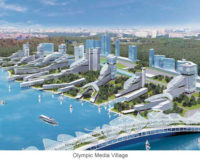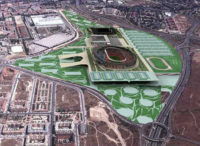Though many consider New York City’s bid to host the 2012 Summer Olympics a long shot, NYC2012, the City’s nonprofit spin-off founded by Deputy Mayor Daniel Doctoroff, submitted its 600-page Bid Book on November 11 to the International Olympic Committee (IOC). The ambitious plan is to be privately funded and is estimated to cost $7.6 billion.
NYC2012’s bid consists of a dizzying array of projects, many already existing, many to be improved, and a handful of large-scale new construction. The plan calls for some 27 sports venues in all five boroughs, as well as New Jersey and Long Island, all within a 20-mile radius of an Olympic Village. Each venue would be connected to the village, media centers, and hotels via an expanded network of public transportation: new rail stations, augmented subway service, special ferries, and buses.
Planned permanent and temporary venues include a massive $185 million complex of sites within Flushing Meadows-Corona Park in Queens for canoeing, kayaking, rowing, water polo, tennis, and archery; a $77 million Bronx Velodrome and Arena for cycling and badminton; a $145 million Olympic Aquatic Center in the yet-to-be-built Williamsburg Waterfront Park, in Brooklyn, for swimming and beach volleyball.
The crown jewel is the Olympic Village on the east bank of the East River, directly opposite the United Nations, in a quiet industrial area of Long Island City, Queens. Plans for the 61-acre site were submitted and reworked by Morphosis after the Santa Monica–based firm won a design competition. The plan would cost over $1.6 billion and would house 16,000 athletes, trainers, and officials in about 4,400 apartments. Morphosis describes the residential component as a “dense, undulating, ribbonlike structure that gracefully wraps around the edges of the site.” Amid the curving buildings would be 43 acres of parkland, including a central dining hall, a waterfront promenade, a 1,100-foot-long pier with restaurants, three acres of beach, a marina, an urban forest and lawn, playing fields, and a wetland estuary that would absorb storm runoff and filter the water before releasing it into the East River. Following the Olympics, the site would be converted into conventional housing.
The two largest and most critical sports venues both happen to be controversial mega-projects already in development and unrelated to the Olympics: a $657 million downtown Brooklyn “Atlantic Yards” Arena for the NBA’s Nets, a Frank Gehry–designed 19,000-seat basketball arena that would double as the Brooklyn Olympic Stadium; and a highly divisive plan for a 75,000-seat Olympic Stadium—aka the Jets Stadium—on Manhattan’s West Side, estimated at $1.5 billion. The stadium, designed by Kohn Pedersen Fox, has been opposed by a number of local community and business interests, though it enjoys high-powered political support. It has yet to clear major planning hurdles. Doctoroff and other key bid members admit that New York has little chance of selection without the
stadium, but Doctoroff remains positive, declaring that he wants “shovels in the ground” before the IOC makes its final choice.











